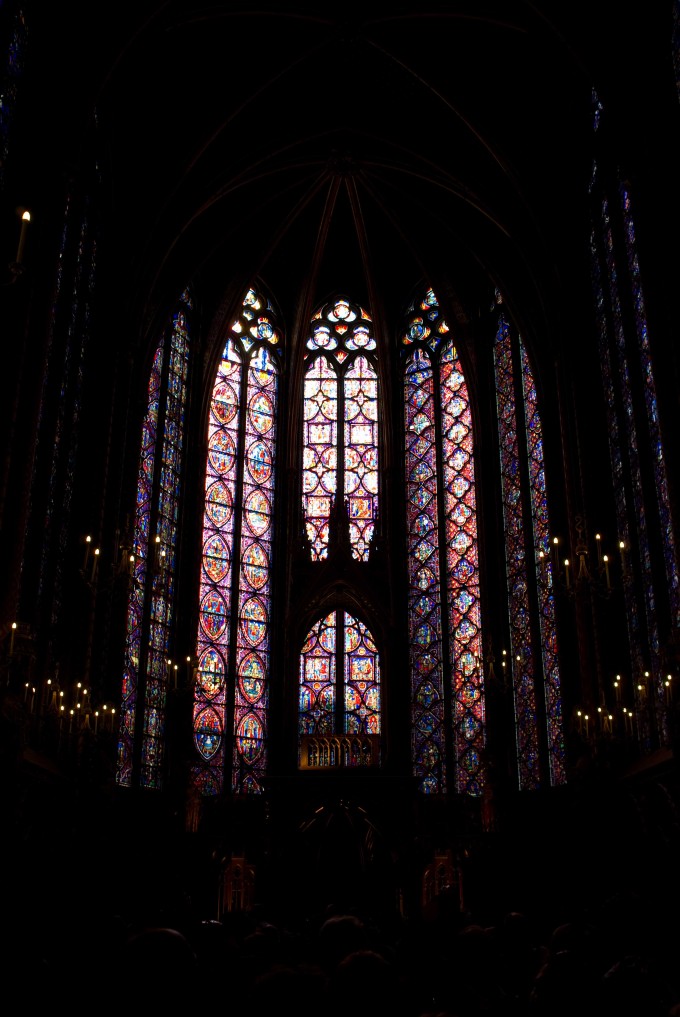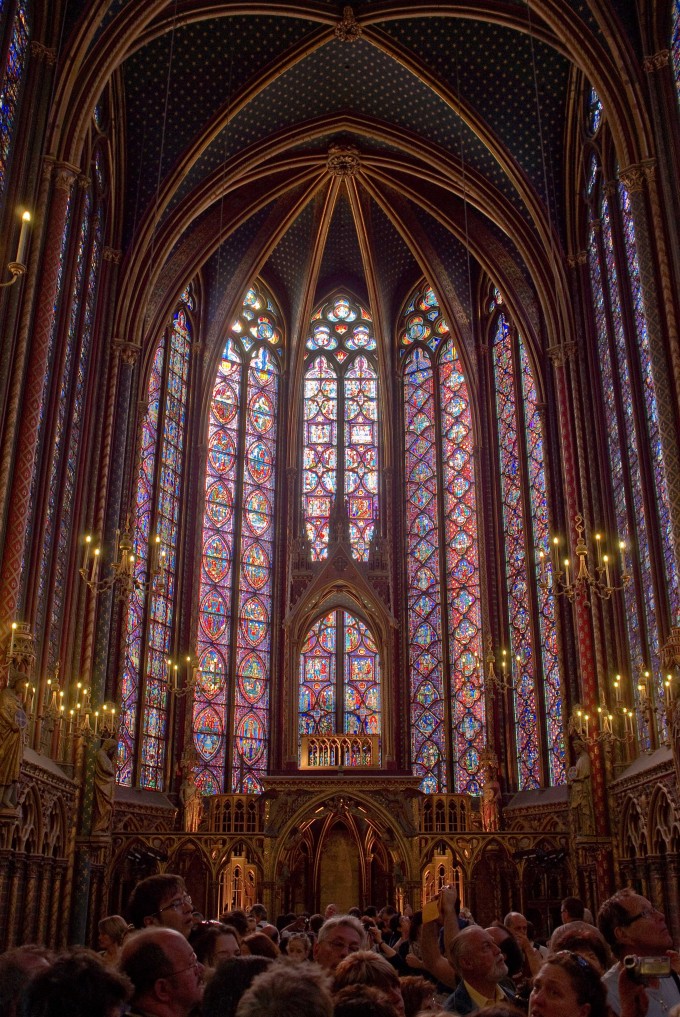USER REPORT: The Leica X1 Dynamic Range by George Sutton
The Leica X1 has a lot of limitations offset by outstanding strengths. I think it works best as a walk-around camera in a city. Color is exemplary. Another strength I have discovered is the camera’s range.
Recently I was in the Sainte-Chapelle chapel in Paris with its spectacular stained glass windows. Photographing inside the chapel poses the typical challenge of exposing windows while preserving any detail in the much darker room. To get the windows I underexposed the original shot, shown below, by 2/3 stop. The windows are in direct sun. In the raw photo, the windows were still a little overexposed but the the rest of the room was dark. In Photoshop I reduced the exposure of the raw file an additional 1 1/3 stops to get the windows right, dialed up the fill light to the max, then fine tuned it more with the tone curve.
The result is the second photo. Preserving that much detail in the otherwise dark shadows is truly amazing. Kudos to Leica.
CLICK ON THE IMAGES FOR MUCH LARGER VERSIONS





The 1st pic is typically underexposed ( like you mentioned- to expose for the stained glass) and i find it amusing that several comments say they prefer it. Any camera can produce a shot like that and will hold very little detail from the mid tones down to the black at the very end of the scale. The X1 in this demonstration ( a brilliant choice of subject, difficult lighting, no flash, and no super extended ISO range to choose from on the camera) is simply astounding to me, with incredible detail, super colour and lastly, that super high quality Leica look and feel.
Well done with the post processing you did a pretty good job in difficult conditions.
I’m very impressed and now struggling to hold out from buying the X1 before i get to my savings plan for a old and very well used M8-
All the best and i hope to see more of your pictures.
Amazing. Thanks for sharing, great to see what a fine camera ‘we’ have 🙂
Having access to RAW files is a wonderful asset to all of us in the digital age. The amount of detail that can be recovered, particularly from shadows, is quite astounding. Wondering, as someone with limited experience with developing their own film, was detail recovery like this doable with film too, but to a lesser degree?
Zaph, absolutely. A film like Tri-X. for example, can easily record 17-20 stops. A situation as above, could easily be rendered by shooting Tri-X, as an example, at 200ISO, overexposing and under-developing, with reduced agitation or even stand development. With color film, something like the new Portra 400 could do a wonderful job but it would be almost impossible with transparencies (slides), without some kind of fill light, as the latitude there is quite narrow, with little room at the top.
What a pleasure to see those stain glass windows…
I’d like to see the first one in B&W, and the second 1 stop at least below current setting. But no question about X1’s capabilities, I took a similar shot at the St Patrick’s in midtown mahanttan with my Nikon D80, 35mm f1.8 G, X1 puts mine in shame…
I definitely prefer the second. The first looks like a classic P&S snapshot.
But it is too bad the stained glass got toned down when you lifted the shadows. I’m sure with a little more effort in post this could be even nicer.
Thanks for sharing.
Yes, sorry to burst that bubble but this has nothing do with a camera’s abilities or dynamic range. It’s all about exposing correctly for your medium and post processing (surprise, it is the same with film). Expose to the right and recover in post processing. As simple as that. In digi-world, most of your info (pixels) is in the highlights part of your histogram. When you underexpose (ie, expose for that window) you actually lose 50% (or more) of information. That’s what your recovery slider does in Lightroom (if you use Lighroom). Basically, NEVER expose for the highlights.
“Basically, NEVER expose for the highlights”
I think that really depends what you are shooting with. Certainly when using compact cameras, my experience is the exact opposite. A blown highlight is gone for good, and recovery isn’t bringing it back. Shadows on the other hand, seem to be much easier to coax the information back from. I know that’s likely not the case with an M9 or a 1Ds, their RAW files seem to retain a heck of a lot of highlight data, but with compact cameras it’s been my experience that exposing for the highlights is often the way to go.
Or really, the upper end of the midtones – with the cameras I use, like XZ-1 & S90, I can get around 1/2 stop out of highlights, and 1-1/2 stops out of shadows.
I know that may not apply to most here, who shoot with much better equipment, but there are a lot of people who aren’t quite at that level yet who read Steve’s site, and I think if they followed “NEVER expose for the highlights” they’d be wondering why it wasn’t working for them.
Yes, this is referring to this case with the X1 and like cameras in this price range and capabilities, shooting RAW. Obviously, with a less expensive point and shoot, not shooting RAW, it is a different story.
I’m still talking about shooting RAW, just with cameras that have a bit less dynamic range.
Dynamic range is important. A camera phone and most point and shoot cameras could not capture this kind of detail in the shadows unless they exposed for the shadows and blew the highlights. Optimal photos involve a combination of correct exposure and the camera’s ability to capture the full range of light. it is ridiculous to say that any camera could take photos as good as any other camera if properly exposed.
This is certainly relevant to a camera’s dynamic range. The ability to boost shadows and maintain detail without banding or other artifacts is essentially all that sets most current aps-c cameras apart, at this point.
BTW, ETTR is somewhat of an archaic approach in relation to today’s sensor technology. In fact, exposing too far right can often lead to color issues, especially if you expose midtones over 1EV of middle. These days, exposing middle grey where your camera’s meter is calibrated works very well.
Please tell me you are aware this sort of performance is not limited to Leica cameras.
I can do that all day long with my D700 and X100.
Please don’t burst leica bubbles :). But even when you can easily manage to lift more shadows and end up much less noise with D700 or 5d (faces on the example above look like some of Georges Seurat’s pointillist portraits) they’ll say that some magical element is missing.
Hmmm. Snarky comments aside, I don’t recall saying it is Leica magic and no other camera will do as well. I simply said the X1 has good dynamic range, especially for a light walk around camera. Period. The X100 may do as well and so would a good DSLR. And I understand I could possibly take a better photo with my 1Ds III but I wouldn’t be surprised if the X1 was close. The point was, taking a DSLR into that place would be a real problem because of the crowd.
Also, the faces are grainy, but not that much and could be fixed. I generally find noticable grain from any camera if the shadows are pushed very far. Exposing to the right would have reduced the grain but the highlights, meaning most of the windows, would be blown and the shot ruined.
I love the second photo for it’s surrealistic qualities.
+1
To me the optimal result would be somewhere between the two. Still – the process-ability of the RAW file is impressive.
I agree that the optimal photo would be somewhere between the two. These photos are only intended to show the range of the X1. And I don’t doubt that a good DSLR will do as well, but no DSLR is as easy to carry into such a crowded place and get a shot. The point is that the X1 compares to a DSLR but weighs a few ounces and is a fraction of the size and weight of a DSLR. My backpack with Canon 1Ds III plus lenses weighs 30+ pounds and would be harder to use in this very crowded situation. A Fuji X100 may work as well — I don’t know because I have not shot an X100. I am only showing the remarkable range of the X1. Don’t read any more into this review than that.
These phtos are beautiful! The fine details of sculptures and stained glass…allucinant is beauty! Really makes you want to have good equipement. Leica is the best! Sylvie Idea une petite “amateur” de photos.
I like both shots in different ways. Nice work.
I actually prefer the first photo much better
Me 2
+1